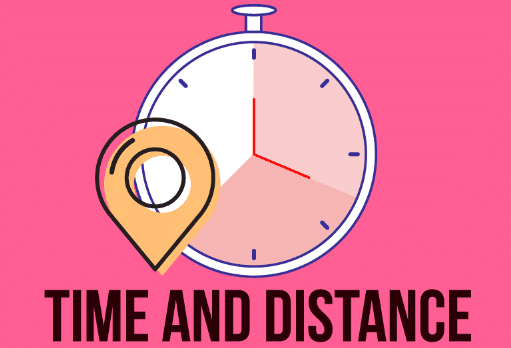Time and Distance | Quantitative Techniques for CLAT PDF Download

Speed is a very basic concept in motion which is all about how fast or slow any object moves. We define speed as distance divided by time.
Distance is directly proportional to Velocity when time is constant.
Few Formulae
- Distance travelled = speed x time
- Speed = distance / time
- Time = distance / speed1
km/hr = (5/18) meter / sec
1 metre / sec = 18 / 5 km / hr.
If the time taken, to travel two distances with different speeds is equal then
Average speed = (speed1 + speed2) / 2
Also
- average speed = total distance travelled / total time taken
- if two distances travelled are equal and two speeds are x km /hr and y km / hr then average speed =
- if 3 equal distances are travelled at speeds x km /hr, y km/ hr and z km/hr respectively then average speed =
Formulae for Questions on Train
- To pass a pole or signal post or a standing man, a train has to travel a distance equal to its length. So, the time taken to pass a pole = length of the train/ speed of the train
- To pass a platform of length A, the train has to travel a distance equal to its length + the length of the platform (A). So, time taken by the train (length T) to pass a platform (length A) = T+A / Speed
- Let the speeds of two trains be x km/hr and y km /hr then
The relative speed if the direction of the trains is the same = (x – y) km/ hr
The relative speed if the direction of trains are opposite to each other
= (x+y) km /hr
Example 1: A bike crosses a bridge at a speed of 180 km/hr. what will be the length of the bridge if the bike takes 3 minutes to cross the bridge?
Solution: Length of the bridge = distance travelled by the bike in 3 minutes = speed x time
Speed = 180 km/hr = (180 x 5) / 18 = 50 meters / sec.
Time = 3 x 60 = 180 seconds.
So, the length of the bridge
= 50 X 180 meters
= (50 x 180) / 1000 km = 9 km
Example 2: Two persons are moving in the direction opposite to each other. The speeds of the two persons are 8 km/hr and 5 km per hour. Find their relative speed with respect to each other.
Solution: We know that when two objects move in the direction opposite to each other, the relative speed is the sum of two speeds.
So, required relative speed = 8 + 5 = 13 km/hr
Example 3: Two trains A and B are moving at speeds in the ratio of 2:5. Find the ratio of the time taken to travel the same distance.
Solution: The ratio of time taken is inverse of the speeds of the two cars.
i.e. since speeds are 2 : 5
so, the time must be 5 : 2
Example 4: Prem can cover a certain distance in 42 minutes by covering 2/3 of the distance at 4 km/hr and the rest at 5 km/hr. find the total distance.
Solution: Let the total distance be x
So, as per the given condition.
Distance / speed + distance / speed = total time
Or (2x/3) x ¼ + (x/3) x (1/5) = 42/60
Or x/2 + x/5 = 42/20
7x/10 x= 42/20
X = 3 km
Example 5: A man completes 60 km of a journey at 12 km/hr and the remaining 80 km of the journey in 5 hours. Find the average speed for the whole journey.
Solution:
First part of the journey:
- Distance = 60 km
- Speed = 12 km/h
- Time = Distance / Speed = 60 / 12 = 5 hours
Second part of the journey:
- Distance = 80 km
- Time = 5 hours (given)
Total distance for the journey:
- Total distance = 60 km + 80 km = 140 km
Total time for the journey:
- Total time = 5 hours (first part) + 5 hours (second part) = 10 hours
Average speed for the whole journey:
- Average speed = Total distance / Total time = 140 / 10 = 14 km/h
So, the average speed for the whole journey is 14 km/h.
Example 6: A car travels from A to B at a speed of 58 km/hr and travels back from B to A at a speed of 42 km/hr. what is the average speed of the car in covering the distance both ways?
Solution: Since the car travels an equal distance with different speed, the average speed is the harmonic mean of the two speeds.
Average speed =
Example 7: The speeds of A and B are in the ratio 3 : 4. A takes 20 minutes more than the time taken by B to reach a destination. In what time does A reach the destination
Solution: Let the speeds of A and B be 3x and 4x, respectively.
Let the time taken by A be t hours, so the time taken by B is t - 1/3 hours (since A takes 20 minutes more).
Use the formula Time = Distance / Speed for both A and B:
- Time taken by A = D / (3x)
- Time taken by B = D / (4x)
According to the given condition:
D / (3x) = D / (4x) + 1/3
Solving this equation gives D = 4x.
Substituting D = 4x in the time equation:
Time taken by A = 4x / (3x) = 4/3 hours = 80 minutes.
So, A reaches the destination in 80 minutes
Example 8: A train crosses a platform in 20 seconds but a man standing on the platform in 8 seconds. Length of the platform is 180 meters. Find the length of the train and its speed.
Solution:
Let the length of the train be "L" meters and its speed be "S" meters per second.
When the train crosses a man, it covers its length in 8 seconds.
So, L = S × 8. ........... (1)
When the train crosses the platform, it covers the train's length plus the platform's length (L + 180) meters in 20 seconds.
So, L + 180 = S × 20 .............. (2)
From Equation 1, L = 8S.
Substitute this in Equation 2: (8S) + 180 = 20S.
Simplify to get S = 15 m/s.
Using L = 8S, we find L = 8 × 15 = 120 meters.
So, the length of the train is 120 meters, and its speed is 15m/s.
Example 9: A train running at 54 km/hr. takes 25 seconds to pass a platform and 15 seconds to pass a man walking at 6 km/h in the same direction in which the train is going. Find the length of the train and the length of the platform.
Solution: Let x and y be the length of the train and of the platform respectively.
Speed of the train w.r.t the man = 54 – 6 = 48 km/ph
= 48 x 5/18 = 40/3 meter / second
In passing the man the train covers its own length with the relative speed.
So the length of the train = Relative speed x time
x = (40/3 x 15) m = 200 m.
Speed of the train = 54 x 5/18 = 15 m/second.
Distance travelled to pass the platform = x + y
So, x + y = 200 + y
So, (200 + y) / 15 = 25
Or y + 200 = 375
Or y = 175 meters.
|
49 videos|179 docs|73 tests
|
FAQs on Time and Distance - Quantitative Techniques for CLAT
| 1. What is the formula to calculate distance when time and speed are known? |  |
| 2. How can I convert hours into minutes when calculating time? |  |
| 3. What units are commonly used to measure distance, speed, and time? |  |
| 4. How do I calculate speed if I have distance and time? |  |
| 5. What are some real-life applications of time and distance calculations? |  |

















